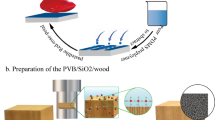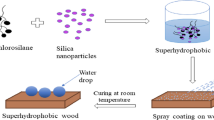Abstract
Polydimethylsiloxane (PDMS) and hydrophobic silica nanoparticles (HSNP) were applied to coat wood surfaces to decrease boron release from DOT (disodium octaborate tetrahydrate) treated wood. The surface-modified specimens were then subjected to a 14-day-leaching course followed by mold resistance tests under laboratory conditions. Water absorption, dimensional stability and water contact angle of the modified wood specimens were then determined. FTIR analysis and SEM imaging were also performed for characterization of the modified wood surfaces. Retention level of 3.3 kg/m3 was retained in the DOT and PDMS-treated wood specimens after the leaching process, but nearly no boron remained in the wood specimens treated with DOT only and DOT + HSNP. In accordance with leaching tests, the DOT and PDMS-treated specimens showed highest performance against mold fungi even after leaching tests; however, no complete protection was achieved in both DOT + HSNP and DOT-only treated specimens. The PDMS and HSNPs coated wood samples displayed water contact angles of 114° and 172°, respectively. The comparison of chemical, wetting and structural characteristics of the modified wood samples before and after leaching showed similar behavior. More detailed research is needed to obtain a better understanding of the mechanisms of interaction between PDMS/HSNP and wood surfaces.







Similar content being viewed by others
Availability of data and material
Data used for this work are available from the corresponding author upon reasonable request.
Code availability
Not applicable.
References
Abbot W, Woodward B, West M (2000) Efficacy of copper borax preservative against wood decay. In: Proceedings of 97th Annual Meeting of the American Wood-Preservers’ Association (AWPA). Minneapolis Marriott City Center Minneapolis, Minnesota, May 20–23, 2000. Volume 97. American Wood-Preservers’ Association, Granbury, Texas
Annual Book of ASTM Standards, Vol. 04.10. American Society for Testing Materials, West Conshohocken, Pennsylvania, USA.
ASTM (2019) ASTM D4445–10. Standard Test Method For Fungicides For Controlling Sapstain And Mold On Unseasoned Lumber (Laboratory Method)
AWPA (2021a) AWPA A21-16. Standard Method for the Analysis of Wood and Wood Treating Solutions by Inductively Coupled Plasma Emission Spectrometry. Annual Book of AWPA Standards. American Wood Protection Association ,AWPA, Birmingham, Alabama, USA.
AWPA (2021b) AWPA A7–19. Standard Wet Ashing Procedures for Preparing Wood for Chemical Analysis. Annual Book of AWPA Standards. American Wood Protection Association, AWPA, Birmingham, Alabama, USA.
Bergamonti L, Berzolla A, Chiappini E, Feci C, Maistrello L, Palanti S, Prediari G, Vaccari G (2017) Polyamidoamines (PAAs) functionalized with siloxanes as wood preservatives against fungi and insects. Holzforschung 71(1):65–75
Brinker CF, Scherer GW (1990) Sol–gel science. Academic Press, San Diego
Brzoska J, Azouz IB, Rondelez F (1994) Silanization of solid substrates: a step toward reproducibility. Langmuir 10(11):4367–4373
BS EN (2020). BS EN 84. Durability of wood and wood-based products. Accelerated ageing of treated wood prior to biological testing. Leaching procedure. British Standards Institution (BSI), 10 pp. ISBN: 9780539003710.
Bücker M, Böcker W, Reinsch S, Unger B (2001) Entwicklung umweltvertra ̈glicher Holzverbundwerkstoffen mit ver- besserter biologischer und Feuchtebesta ̈ ndigkeit. In: Wielage B, Leonhardt G (eds) Verbundwerkstoffe und Werkstoffverbunde. Wiley-VCH, Weinheim, pp 463–467
Celik N, Torun I, Ruzi M, Esidir A, Onses MS (2020) Fabrication of robust superhydrophobic surfaces by one-step spray coating: Evaporation driven self-assembly of wax and nanoparticles into hierarchical structures. Chem Eng J 2:125230
Donath S, Militz H, Mai C (2004) Wood modification with alkoxysilanes. Wood Sci Technol 38:555–566
Donath S, Militz H, Mai C (2006) Creating water-repellent effects on wood by treatment with silanes. Holzforschung 60:40–46
Falbe J, Regnitz M (1995) CD-Römpp Chemie Lexikon, 9th edn. Georg Thieme, Stuttgart
Forsberg P, Nikolajeff F, Karlsson M (2010) Cassie-Wenzel and Wenzel-Cassie transitions on immersed superhydrophobic surfaces under hydrostatic pressure. Soft Matter 7:104–109
Freeman MH, McIntyre CR, Jackson J (2009) A critical and comprehensive review of boron in wood preservation. Proc Am Wood Protect Assoc 105:279–294
Furuno T, Imamura Y (1998) Combinations of wood and silicate. 6. Biological resistance of wood-mineral composites using water glass–boron compound system. Wood Sci Technol 32:161–170
Furuno T, Uehara T, Jodai S (1991) Combinations of wood and silicate. 1. Impregnation by water glass and applications of aluminum sulfate and calcium chloride as reactants. Mokuzai Gakkaishi 37:462–472
Furuno T, Shimada K, Uehara T, Jodai S (1992) Combinations of wood and silicate. 2. Wood–mineral composites using water glass and reactance of barium chloride, boric acid, and borax and their properties. Mokuzai Gakkaishi 38:448–457
Furuno T, Uehara T, Jodai S (1993) Combinations of wood and silicate. 3. Some properties of wood–mineral composites using the water glass–boron compound system. Mokuzai Gakkaishi 39:561–570
Gao L, Gan W, Xiao S, Zhan X, Li J (2016) A robust superhydrophobic antibacterial Ag–TiO2 composite film immobilized on wood substrate for photodegradation of phenol under visible-light illumination. Ceram Int 42:2170–2179
Hill CAS, Farahani MRM, Hale MDC (2004) The use of alkoxysilane coupling agents for wood preservation. Holzforschung 58:316–325
Hill C (2006) Wood modification. Chemical, thermal and other processes. Wiley series in renewable resources. John Wiley & Sons, Ltd., USA, ISBN 0-470-02172-1.
Hsieh CT, Chang BS, Lin JY (2011) Improvement of water and oil repellency on wood substrates by using fluorinated silica nanocoating. Appl Surf Sci 257(18):7997–8002
Hwang WJ, Kartal SN, Shinoda K, Imamura Y (2005) Surface treatment for preventing decay and termite attack in wood using didecyl dimethyl ammonium tetrafluoroborate (DBF) incorporated with acryl-silicon type resin. Holz Roh- Werkst 63:204–208
Kartal SN, Hwang WJ, Yamamoto A, Tanaka M, Matsumara K, Imamura Y (2007) Modification of wood with a commercial silicon emulsion: effects on boron release and decay and termite resistance. Int Biodeterior Biodegrad 60:189–196
Kartal SN, Yoshimura T, Imamura Y (2009) Modification of wood with Si compounds to limit boron leaching from treated wood and to increase termite and decay resistance. Int Biodeterior Biodegrad 63:187–190
Kartal SN, Hwang WJ, Katsumata N, Shinoda K, Yoshimura T, Imamura Y (2004) Effect of acryl-silicon type resin on boron leachability. 3rd International Symposium on Surfacing and Finishing of Wood, Kyoto, Japan, IUFRO Division 5, Working Party 5–04.12, Surfacing and Finishing of Wood, November 24–26, 2004
Kocaefe D, Huang X, Kocaefe Y (2015) Dimensional stabilization of wood. Curr Forestry Rep 1:151–161
Lin LH, Chen KM (2006) Surface activity and water repellency properties of cleavable-modified silicone surfactants. Colloid Surf A Physico-Chem Eng Aspects 275:99–106
Liu C, Wang S, Shi J, Wang C (2011) Fabrication of superhydrophobic wood surfaces via a solution-immersion process. Appl Surf Sci 258(2):761–765
Lloyd JD (1997) International status of borate preservative systems. In: Proceedings of the Second International Conference on Wood Protection with Diffusible Preservatives and Pesticides. Proceedings No. 7284. Forest Products Society, Madison, WI, pp. 45–54
Mai C, Donath S, Militz H (2003) Modification of wood with silicon compounds. In: Proceedings of the First European Conference on Wood Modification. Gent, Belgium, pp. 239–251
Mai C, Militz H (2004a) Modification of wood with silicon compounds. Inorganic silicon compounds and sol–gel systems: a review. Wood Sci Technol 37:339–348
Mai C, Militz H (2004b) Modification of wood with silicon compounds. Treatment systems based on organic silicon com- pounds—a review. Wood Sci Technol 37:453–461
Ogiso K, Saka S (1993) Wood-inorganic composites prepared by sol-gel process II. Effects of ultrasonic treatments on preparation of wood-inorganic composites. Mokuzai Gakkaishi 39:301–307
Ruzi M, Celik N, Onses MS (2022) Superhydrophobic coatings for food packaging applications: A review. Food Packag Shelf Life 32:100823
Sahin F, Celik N, Ceylan A, Pekdemir S, Ruzi M, Onses MS (2022) Antifouling superhydrophobic surfaces with bactericidal and SERS activity. Chem Eng J 431:133445
Saka S, Sasaki M, Tanahashi M (1992) Wood-inorganic composites prepared by sol–gel processing. 1. Wood-inorganic composites with porous structure. Mokuzai Gakkaishi 38:1043–1049
Saka S, Miyafuji H, Tanno F (2001) Wood-inorganic composites prepared by the sol–gel process. J Sol Gel Sci Technol 20:213–217
Sebe G, Brook MA (2001) Hydrophobization of wood surfaces: covalent grafting of silicone polymers. Wood Sci Technol 35(3):269–282
Sebe G, Tingaut P, Tchiama RS, Petraud M, Grelier S, De Jeso B (2004) Chemical reaction of maritime pine sapwood (Pinus pinaster Soland) with alkoxysilane molecules: a study of chemical pathways. Holzforschung 58:511–518
Teisala H, Baumli P, Weber SA, Vollmer D, Butt HJ (2020) Grafting silicone at room temperature—a transparent, scratch-resistant nonstick molecular coating. Langmuir 36(16):4416–4431
Torun I, Ruzi M, Er F, Onses MS (2019) Superhydrophobic coatings made from biocompatible polydimethylsiloxane and natural wax. Prog Org Coat 136:105279
Torun I, Celik N, Ruzi M, Onses MS (2021) Transferring the structure of paper for mechanically durable superhydrophobic surfaces. Surf Coat Technol 405:126543
Tshabalala MA, Kingshott P, Vanlandingham MR, Plackett D (2003) Surface chemistry and moisture sorption properties of wood coated with multifunc- tional alkoxysilanes by sol–gel process. J Appl Polym Sci 88:2828–2841
Ullmann (2002) Ullmann’s encyclopaedia of industrial chemistry, 6th edn. Wiley-VCH, Weinheim
Wang S, Liu C, Liu G, Zhang M, Li J, Wang C (2011) Fabrication of superhydrophobic wood surface by a sol-gel process. Appl Surf Sci 258(2):806–810
Wang S, Wang C, Liu C, Zhang M, Ma H, Li J (2012) Fabrication of superhydrophobic spherical-like α-FeOOH films on the wood surface by a hydrothermal method. Colloids Surf A Physicochem Eng Asp 403:29–34
Wang C, Zhang M, Xu Y, Wang S, Liu F, Ma M, Zang D, Gao Z (2014) One-step synthesis of unique silica particles for the fabrication of bionic and stably superhydrophobic coatings on wood surface. Adv Powder Technol 25(2):530–535
Yamaguchi H (2003) Silicic acid: boric acid complexes as wood preservatives. Wood Sci Technol 37:287–297
Yamaguchi H (2005) Silicic acid/boric acid complexes as ecologically friendly wood preservatives. For Prod J 55(1):88–92
Author information
Authors and Affiliations
Contributions
All authors contributed to the conceptualisation and methodology of the study. Material preparation, data collection and analysis were performed by SNK, EES, MSO, and NC. The first draft of the manuscript was written by SNK and MSO and all authors commented on subsequent versions of the manuscript. All authors read and approved the final manuscript.
Corresponding author
Ethics declarations
Conflicts of interest
The authors have no conflicts of interest to declare that are relevant to the content of this article.
Results of studies involving humans and/or animals
Not applicable.
Additional information
Publisher's Note
Springer Nature remains neutral with regard to jurisdictional claims in published maps and institutional affiliations.
Rights and permissions
Springer Nature or its licensor holds exclusive rights to this article under a publishing agreement with the author(s) or other rightsholder(s); author self-archiving of the accepted manuscript version of this article is solely governed by the terms of such publishing agreement and applicable law.
About this article
Cite this article
Soytürk, E.E., Kartal, S.N., Onses, M.S. et al. Preliminary evaluation of polydimethylsiloxane and hydrophobic silica nanoparticles to improve water repellency and boron leachability in wood. Eur. J. Wood Prod. 81, 89–98 (2023). https://doi.org/10.1007/s00107-022-01883-7
Received:
Accepted:
Published:
Issue Date:
DOI: https://doi.org/10.1007/s00107-022-01883-7




